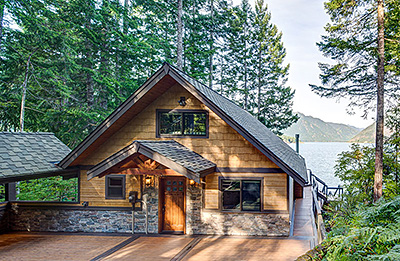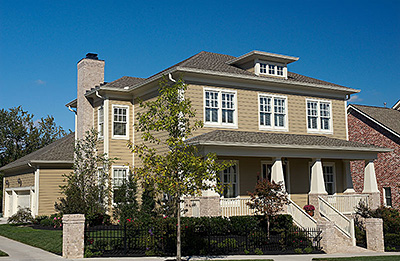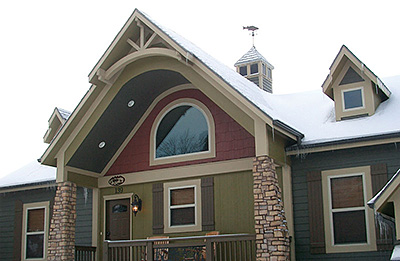Choosing House Siding for Your Region
by Rachel Lyon, Editorial Director for Direct from the Designers™
Even though a new house built near the coastline of Maine might look similar to another constructed in the Arizona desert, their exterior finishing products must be carefully chosen to ensure they can stand up to their climates. Not only do you risk having to replace siding if it’s easily damaged by the elements, but it can compromise the integrity of your home and lead to costly repairs. Be aware of your needs as you shop around—here are some important points you’ll want to keep in mind.
Protection Against Moisture
Resisting rain intrusion is a concern for most locations, and most types of siding hold up well against everything from showers to downpours. Pay attention to seams on any kind of siding, because these are weak spots that can allow moisture to seep into the structural walls and cause rot where you can’t see it. For this reason, you’ll want to minimize the number of seams facing exposure and also take into account how they line up. You can’t usually tell by looking at the fully installed product, but many options have overlapping edges that help to better lock pieces together and improve the moisture shield.
As a natural material, wood is at risk of failing when used as siding. Moisture-proofing to prevent rot is just the beginning, because it still provides an ideal environment for fungus growth and termite infestation. Though obviously very different, these organisms both use dead and harvested wood as a food source, and it’s difficult to combat them once they’ve taken hold. They are also highly prevalent in hot, humid areas, so they should be addressed in the same breath as moisture concerns. Choose an engineered wood product treated with waxes to keep out water and zinc borate to deter fungus and termites if you want beautiful wood siding without dealing with these drawbacks.
Wind and Impact Resistance
If you live in an idyllic location with mild weather, you might not have to worry about your home standing strong against powerful gusts and airborne debris. But if you choose to build anywhere near a beach or ocean, in Hail Alley, or another place that experiences rough and stormy conditions, you’ll want to know how well your first line of defense—the outermost shell that is your siding—can protect you and the investment you’ve made in your home.
Strong winds that catch at the bottom of the wall or through a lip on an uneven application make short work of stripping off siding. The low pressure that comes with a hurricane can suck everything from shingles to whole sheets of vinyl away from a house. It’s important to consider the wind pressure rating of products to prevent this, but keep in mind that proper installation is crucial and that it isn’t as simple as choosing the best material. There is a lot of variation in performance between brands, even if they produce the same type of siding.
When it comes to protecting against impact damage, a heavy, durably constructed siding is best. Except in extreme cases, damaged siding won’t leave your house at immediate risk. The problem is that unsightly chips, cracks, and dents can expose the underlying structure to moisture and are likely to continue accumulating damage through day-to-day stresses. So even if your region doesn’t experience winds strong enough to strip siding, the wind poses another threat to the soundness of your exterior.
Lasting Looks
Even if your siding stands up to wind and rain, it will eventually show its age. Sometimes this is charming and sometimes it’s an eyesore—aged shakes invoke nostalgic feelings while the buildup of efflorescence on cement-based products usually distracts from their aesthetic appeal. How siding holds up in different conditions depends on what it’s made of. Efflorescence crops up with rain and humidity, so avoid fiber cement if you live in Washington or Florida and don’t like the look of it. In very sunny locations like the Southwest, vinyl can become a problem; it is usually all right in strong sun, but it can melt when that heat is reflected off of Low E windows, which are becoming more popular as concern for energy efficiency grows. And maintenance will be a concern for anybody who chooses natural wood, which can corrode in salt air, fade in harsh sun, and swell and rot in wet environments. Take the time to match the material to your expectations and the amount of care you’re willing to put into it.
If you’re looking for hardy siding to complete your house, LP® SmartSide® offers attractive products in a number of styles to complement every type of home architecture. This engineered wood siding offers the best of natural beauty and man-made resilience, and it addresses the concerns of every region across the United States with its SmartGuard® process. See for yourself why LP® SmartSide® is a sound decision for every state and climate zone!
BROWSE HOME PRODUCT ARTICLES
- Creating a Spa-Like Master Bathroom »
- Designing a Water-Efficient Bathroom »
- Design a Modern Bathroom »
- View All Bathroom Articles »
- Building a New Home »
- Building a Duplex »
- Finding the Right Home Builder »
- View All Building Tips Articles »
- Adding the Right Columns»
- Decorative Touches for Your Interior»
- Shutters for Every Architectural Style »
- View All Columns & Millwork Articles »
- How to Use Specialty Laminates »
- Decorative Touches for Your Home's Interior
- View All Countertops and Surfaces Articles »
- What Goes Into a Great Deck? »
- Decorative Touches for Your Home's Interior »
- View All Decking Articles »
- Choosing Glass for Your Entry »
- Stylish Personas for Your Front Door »
- Using Sidelites and Transoms »
- View All Door Articles »
- Choose Siding for Your Region »
- Get the Most Out of Exterior Paint »
- Mixing Siding to Define Your Exterior »
- View All Exterior Articles »
- Finding the Right Home Builder »
- The Appeal of Small House Plans »
- Choosing the Perfect Floor Plan »
- View All Finding a Home Plan Articles »
- Colorful Flooring for Your Home »
- Designing With Different Widths»
- Chic, Neutral, Gray Flooring »
- View All Flooring Articles »
- Garage Doors That Add Curb Appeal »
- Caring for Your Garage Doors »
- Benefits of Insulated Garage Doors »
- View All Garage Door Articles »
- Reclaimed Products for Your Home »
- Building a Green and Stylish Home »
- Benefits of Building with SIPS »
- View All Green Building Articles »
- Cool Gadgets for Your New Home »
- Creating a Hi-Tech Home »
- Efficient Gifts for New Homeowners »
- View All Home Electronics Articles »
- Improve Your Home's Air Circulation »
- How to Improve the Air Circulation in Your Home »
- View All HVAC Articles »
- Bedrooms Designed for Sleep »
- Selecting a Fireplace for Your Home »
- Crafting a Luxurious Master Suite »
- View All Interior Design Articles »
- Design the Perfect Outdoor Space »
- Dive into a Beautiful Pool »
- Design a Sizzling Outdoor Kitchen »
- View All Outdoor Living Articles »
- Apps to Help You Pick Paint Colors »
- Create the Perfect Mood with Paint »
- How to Read the Color Wheel »
- View All Painting & Decorating Articles»
- Creating a Spa-Like Master Bathroom »
- High-Impact Kitchen Upgrades »
- Creating a Water Efficient Bathroom »
- View All Plumbing Fixtures Articles»
- Cladding That Complements Your Exterior »
- Reasons to Consider Prefinished Siding »
- View All Siding & Cladding Articles»
- All About Solar Powered Skylights »
- Natural Lighting for the Dark Corners of Your Home »
- Design a Better Bedroom with Skylights »
- View All Skylight Articles»
.png)
.png)



